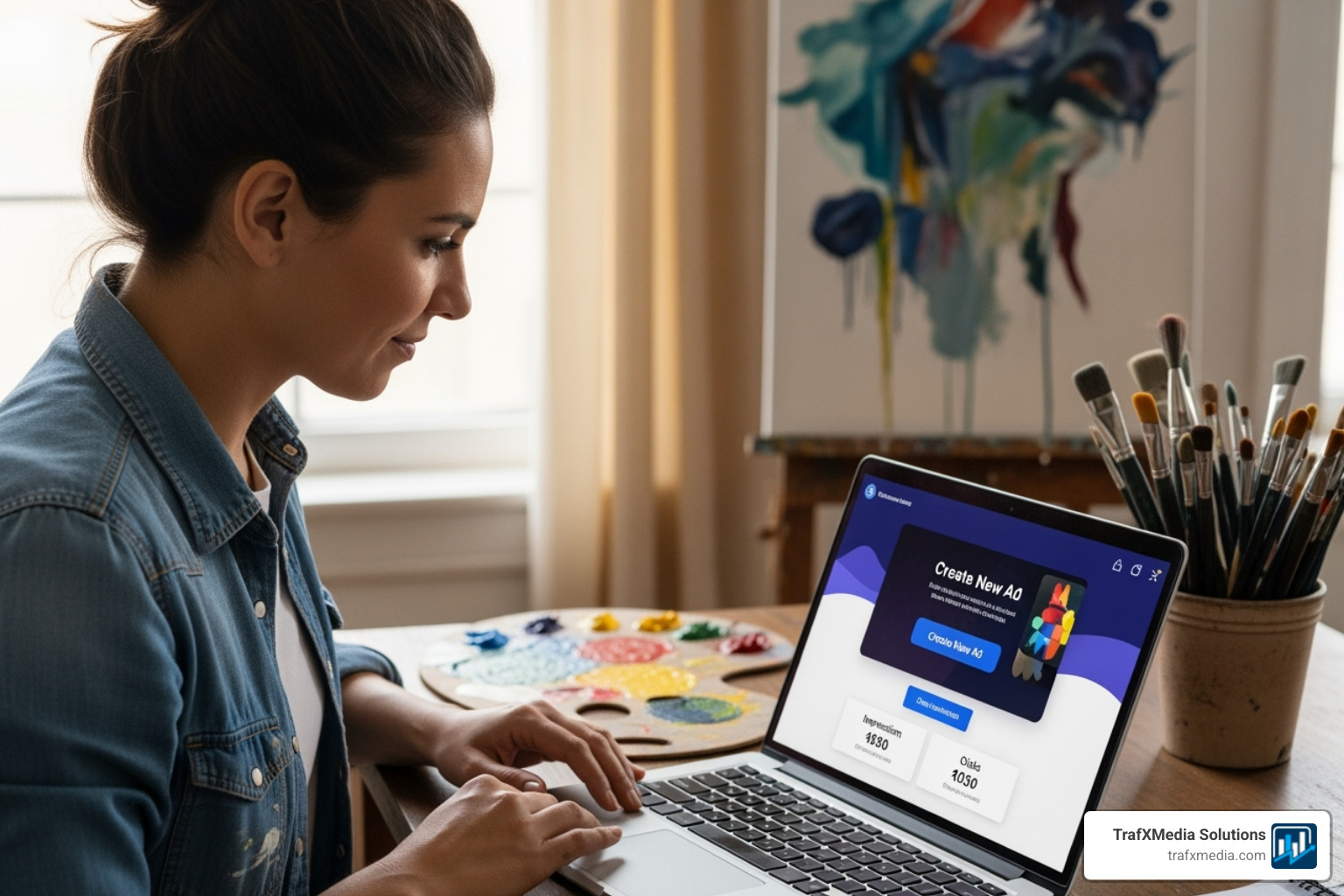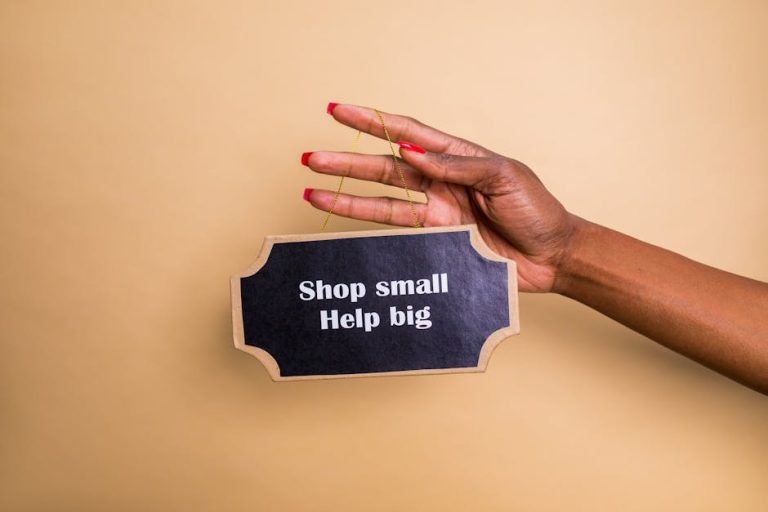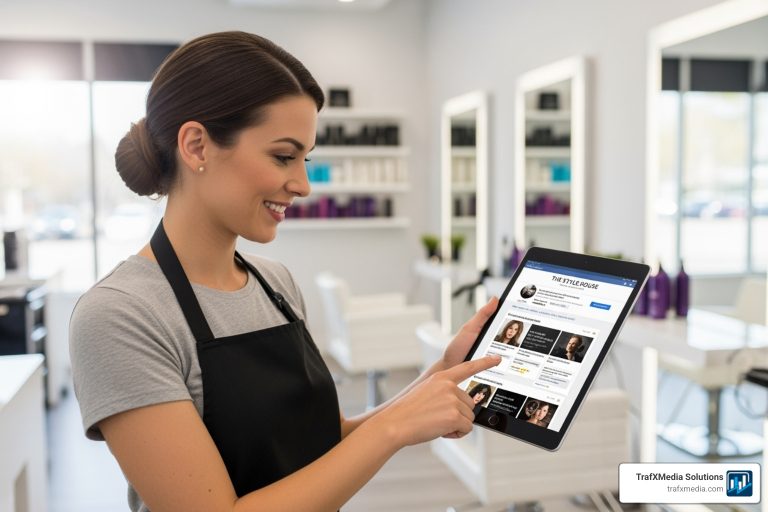Artful Advertising: Google Ads for Creative Minds
Why Google Ads is a Game-Changer for Artists
In today’s digital-first world, the romantic notion of the starving artist waiting to be finded is not just outdated—it’s a failing business model. The power has shifted from exclusive galleries and gatekeepers to the creators themselves. Google ads for artists is a primary engine of this change, connecting your unique work directly with a global audience actively searching for it. Whether you’re a painter in a small studio, a musician composing your next track, or a gallery owner curating a new exhibition, Google Ads provides the tools to transform your passion into a sustainable career.
Here’s a deeper look at what Google Ads can do for you:
- Target Active Searchers with Precision: This is the core magic of Google Search Ads. Unlike social media where you interrupt users, here you connect with them at the exact moment of intent. When someone types “large abstract oil painting for living room” or “hire jazz trio for wedding San Francisco,” your ad can be the first thing they see. You’re not just finding an audience; you’re finding a motivated one.
- Maintain Absolute Control Over Your Budget: The fear of runaway advertising costs is a major hurdle for many artists. Google Ads eliminates this fear. You can start with a budget as small as $5 or $10 a day. There are no long-term contracts or minimum spends. This allows you to test the waters, gather data, and only scale your investment once you’ve proven a campaign is delivering a positive return.
- Track Real, Measurable Results: Did your ad campaign lead to a print sale? A commission inquiry? A ticket purchase for your show? With conversion tracking, you can measure the exact return on ad spend (ROAS). You’ll know precisely which keywords, ads, and audiences are driving tangible business outcomes, allowing you to cut what isn’t working and double down on what is. Businesses often see an average of $8 in revenue for every $1 spent on Google Ads, a testament to its power when managed correctly.
- Showcase Your Work Visually: Art is a visual medium, and Google Ads accepts this. With Display, Video, and Performance Max campaigns, you can use stunning images of your artwork, behind-the-scenes videos of your creative process, or trailers for your upcoming exhibitions to captivate audiences across millions of websites and on YouTube.
- Dominate Your Local Scene: For artists with a strong local connection—muralists, performing musicians, workshop hosts, or gallery owners—geo-targeting is invaluable. You can target your ads to specific cities, zip codes, or even a one-mile radius around your studio, ensuring you connect with nearby collectors, venues, and fans in your community.
- Retarget and Re-engage Interested Visitors: How many people have visited your online portfolio, admired your work, and then left without taking action? Retargeting (or remarketing) allows you to bring them back. By showing follow-up ads to these previous visitors as they browse other sites, you stay top-of-mind, gently reminding them of the piece they loved and encouraging them to complete the purchase or inquiry.
I’m Richard Taylor, an SEO strategist and business consultant. My career has been dedicated to helping both globally recognized brands and ambitious startups steer the digital marketing landscape. I bring this experience to the creative world, offering unique insights into how artists can leverage powerful tools like Google Ads to build their audience, drive sales, and achieve artistic independence.
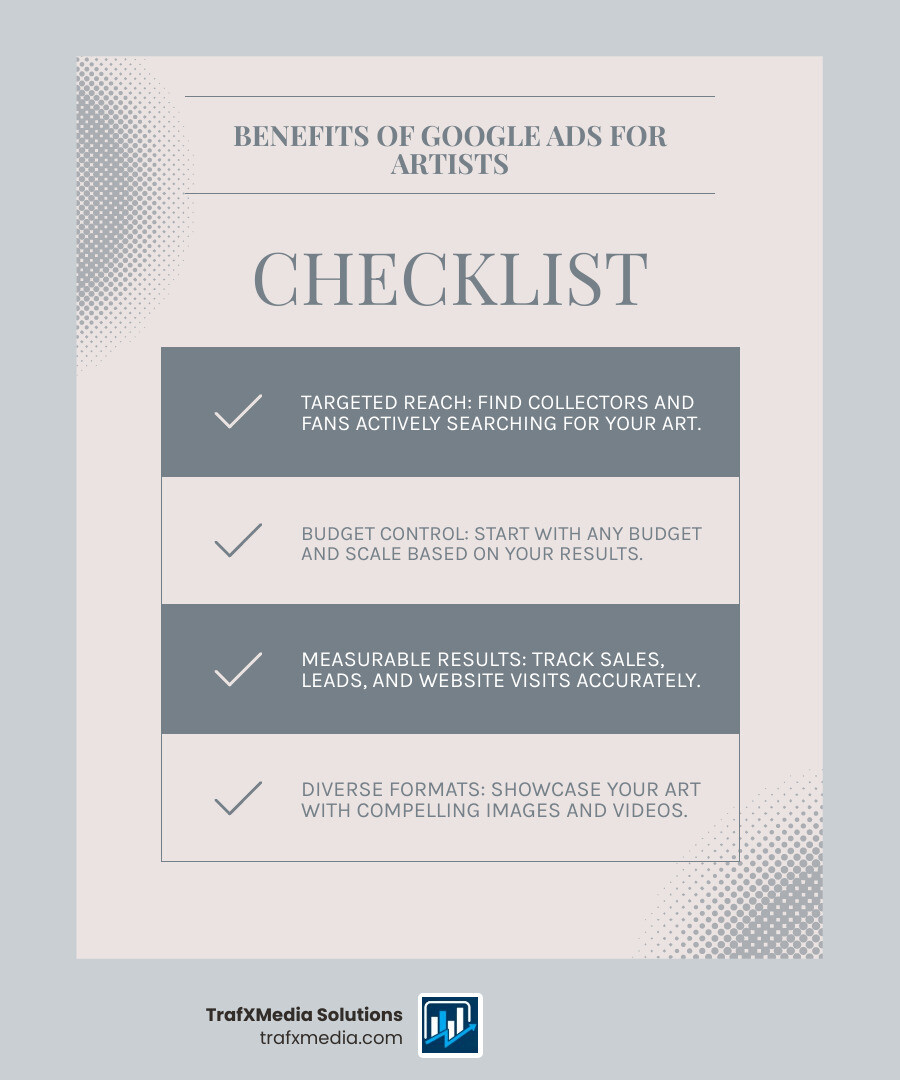
Google ads for artists word guide:
Understanding Your Core Business Goals
Before you spend a single dollar, you must define what success looks like. A campaign without a clear goal is like a ship without a rudder. Your objectives will dictate every subsequent decision, from campaign type and keyword selection to ad copy and landing page design.
Are you aiming for:
- Direct Sales: The most straightforward goal. Are you selling original paintings, limited edition prints, digital music albums, or branded merchandise directly from your website? Your key metric here will be Return on Ad Spend (ROAS).
- High-Quality Leads: For many artists, especially those who do commission work, the goal is not an immediate sale but a conversation. This means gathering contact information (name, email, phone number) from potential clients interested in custom art, music composition, or event bookings. Success is measured by Cost Per Lead (CPL).
- Strategic Website Traffic: Perhaps your immediate goal is to drive more visitors to your online portfolio to build your brand’s authority and email list. While traffic itself is a vanity metric, traffic that leads to newsletter sign-ups or portfolio downloads is a valuable mid-funnel objective.
- Brand Awareness and Reach: Do you want your name or artistic style to become recognizable within a specific niche or geographic area? This is a top-of-funnel goal, often pursued with visual Display and Video campaigns, where success is measured by impressions, reach, and video view-through rates.
- Driving Physical Foot Traffic: Are you trying to get people to visit your brick-and-mortar gallery, open studio, or a specific exhibition? Google’s Local campaigns are designed for this, measuring success through store visit conversions.
- Event and Workshop Registrations: If you teach art classes, music lessons, or host creative workshops, your goal is to fill seats. Your ads should drive users to a registration page, and success is measured by the number of sign-ups and the cost per registration.
- Commission Inquiries: This is a specific type of lead generation focused on high-value, custom projects. The goal is to connect with clients who have a specific vision and are looking for an artist with your unique skills to bring it to life.
Defining Your Ideal Target Audience
Once you know what you want to achieve, you must define who you want to reach. The more specific you are, the more efficient your ad spend will be. Think beyond broad demographics and create detailed personas of your ideal buyers or fans.
For a visual artist, your audience might include:
- The Seasoned Art Collector: High-income individuals, often 45+, who actively follow the art market, visit galleries, and search for specific artists or styles to add to their collection. They use keywords like “original [artist name] painting” or “investment-grade contemporary art.”
- The Interior Designer: A B2B audience looking for unique, statement pieces to complete client projects. They search for terms like “large-scale abstract art for office lobby” or “commissioned sculpture for modern home.” They value professionalism, clear communication, and timely delivery.
- The First-Time Art Buyer: Often younger (25-40), this person is looking to decorate their new home or apartment. They are looking for something meaningful and original but may be more budget-conscious. They use searches like “affordable original art online” or “cool art prints for bedroom.”
- The Gift Giver: Someone looking for a unique, personal gift for a wedding, anniversary, or major milestone. They might search for “custom pet portrait painting” or “personalized song for anniversary.”
For a musician, your audience could be:
- The Dedicated Music Fan: People who actively follow your genre, buy merchandise, and attend live shows. They might be targeted based on their interest in similar artists or music festivals.
- The Wedding Planner or Corporate Event Organizer: A B2B audience searching for live entertainment. They use highly specific, transactional keywords like “hire string quartet for corporate event” or “best wedding band in the Bay Area.”
- The Music Supervisor: A niche but highly valuable audience looking for music to license for films, TV shows, commercials, or video games. They can be targeted via specific industry websites or professional groups.
Google Ads allows you to layer targeting options to hone in on these personas using:
- Demographics: Target by age, gender, parental status, and even household income brackets.
- In-Market & Affinity Audiences: Reach people Google has identified as being actively in the market for products or services like yours (e.g., “Home Decor Enthusiasts”) or who have a long-term interest in a topic (e.g., “Jazz Music Lovers”).
- Custom Audiences: This is where the real power lies. You can build your own audiences by providing Google with a list of keywords people have searched, URLs of websites they have visited (like competitor websites or popular art blogs), or apps they use.
The Ultimate Guide to Google ads for artists
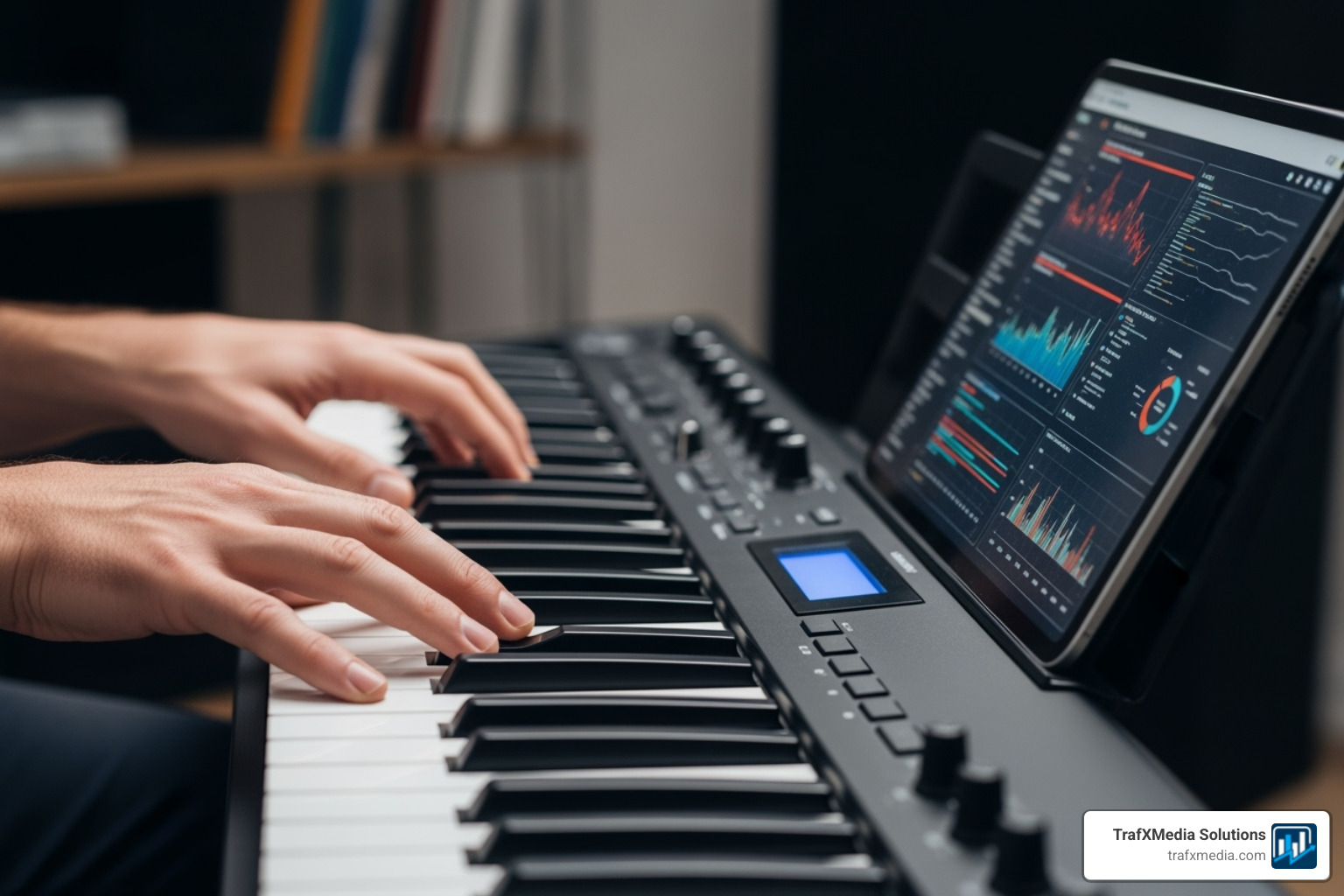
With your foundational strategy of goals and audience in place, it’s time to move into the tactical execution of building your first campaign. This phase is where art meets science. It involves meticulous keyword research to understand the language of your audience, crafting compelling ad creative that stops the scroll, and optimizing your landing page to provide a seamless path from click to conversion.
Mastering Keyword Research: The Language of Your Audience
Keyword research is the bedrock of any successful Search campaign. It’s the process of identifying the specific words and phrases your ideal customers are typing into Google. For artists, this can be tricky, as individual art pieces rarely have high search volume. Therefore, your strategy must be broader, focusing on styles, use cases, and problems you solve.
Here’s a step-by-step guide to effective keyword research:
-
Brainstorm Seed Keywords: Start with the obvious terms related to your work. Think like a customer. What would they search for? Examples include: “abstract expressionism painting,” “custom pet portraits,” “live jazz band,” “San Francisco wedding photographer.”
-
Use Google Keyword Planner: Plug your seed keywords into Google’s free Keyword Planner. This tool will generate hundreds of related keyword ideas, along with data on their monthly search volume and estimated cost-per-click (CPC). Look for a balance between relevance and search volume.
-
Focus on Long-Tail Keywords: These are longer, more specific phrases of three or more words. While they have lower search volume individually, they are far less competitive and attract highly motivated, qualified buyers. For example, instead of targeting the broad and expensive keyword “oil painting,” focus on a long-tail keyword like “large modern landscape oil painting for sale online.” The user searching this knows exactly what they want.
-
Understand Keyword Match Types: How you enter your keywords into Google Ads matters.
- Broad Match: (e.g.,
modern art) – Shows your ad for a wide range of related queries. Use with caution as it can lead to irrelevant clicks. - Phrase Match: (e.g.,
"modern art") – Shows your ad for searches that include the meaning of your keyword. More controlled than broad match. - Exact Match: (e.g.,
[modern art]) – Shows your ad only for searches that have the same meaning or intent as the keyword. This offers the most control and typically the highest relevance.
A good strategy is to start with Phrase and Exact match to control costs and ensure relevance.
- Broad Match: (e.g.,
-
Spy on Your Competitors: Analyze the websites and social media of other successful artists or galleries in your niche. What terms do they use in their descriptions and titles? Tools like SEMrush or Ahrefs can reveal the exact keywords your competitors are bidding on in Google Ads.
-
Build a Robust Negative Keyword List: This is one of the most critical and overlooked steps. Negative keywords prevent your ads from showing for irrelevant searches, saving you a significant amount of money. If you sell original, high-end paintings, you should add negative keywords like
free,cheap,tutorial,how to,DIY,print,poster, andclip artto your campaigns.
Crafting Compelling Ad Creative That Converts
Your ad is your digital storefront window. In a sea of search results, it needs to be compelling enough to earn the click. Your ad creative must be a perfect marriage of enticing copy and high-quality visuals.
- Write Irresistible Headlines: In Responsive Search Ads, you can write up to 15 headlines. Google’s AI will test different combinations to find the best performers. Best practices include: including your primary keyword, asking a question, highlighting your unique selling proposition (USP), and creating a sense of urgency (e.g., “Limited Edition Prints Available”).
- Develop Persuasive Descriptions: You have space for up to four 90-character descriptions. Use this space to elaborate on your headlines, tell a mini-story, and highlight the benefits of your art or service. Mention key features like “Hand-Painted Originals,” “Free Shipping,” or “5-Star Rated Musician.”
- Leverage Ad Extensions: Extensions are extra snippets of information that expand your ad’s size and provide more reasons for users to click. They are free to add and can significantly improve your click-through rate (CTR). Essential extensions for artists include:
- Image Extensions: A must-have for visual artists. Show a small image of your work directly in the search ad.
- Sitelink Extensions: Add links to specific pages on your site, such as “View Portfolio,” “Commission Process,” “About the Artist,” and “Contact Us.”
- Callout Extensions: Short, punchy phrases to highlight key selling points like “Ethically Sourced Materials,” “Worldwide Shipping,” or “Book a Free Consultation.”
- Structured Snippets: Showcase a list of styles, types, or services you offer (e.g., Styles: Impressionism, Abstract, Realism).
- A/B Test Everything: Never assume you know what will work best. Continuously test different headlines, descriptions, and calls-to-action. Create two ad variations in an ad group and let them run. After gathering enough data, pause the underperformer and try to beat the winner with a new variation. This process of iterative improvement is the key to long-term success.
Optimizing Your Landing Page for Conversions
Getting the click is only half the battle. If your landing page—the page users arrive at after clicking your ad—is confusing, slow, or untrustworthy, you will lose the sale. Your landing page must deliver on the promise of your ad and guide the user seamlessly toward your desired goal.
- Message Match: The headline and content of your landing page must directly match the ad that the user clicked. If your ad promised “Custom Pet Portraits,” the landing page should be all about custom pet portraits, not your general portfolio.
- Blazing-Fast Load Speed: In our mobile-first world, patience is thin. If your page takes more than 3 seconds to load, a large percentage of visitors will leave. Use Google’s PageSpeed Insights tool to diagnose and fix speed issues. This often involves compressing image files, which is crucial for image-heavy artist portfolios.
- Mobile-First Design: Your website must look and function flawlessly on a smartphone. Ensure buttons are easy to tap, text is readable without pinching and zooming, and navigation is intuitive.
- High-Impact Visuals and Clear Copy: Showcase your best work with high-resolution images and videos. The copy should be clear, concise, and focused on benefits. An artist bio helps build a personal connection, while testimonials from past clients build powerful social proof and trust.
- A Single, Clear Call-to-Action (CTA): Don’t confuse visitors with too many options. What is the one thing you want them to do on this page? “Shop the Collection,” “Request a Commission Quote,” or “Sign Up for the Workshop.” Make the CTA a prominent button with action-oriented text.
Choosing the Right Google Ads Campaign Type
Google Ads is not a one-size-fits-all platform. It offers a diverse suite of campaign types, each designed to achieve specific marketing objectives and connect with users at different stages of their journey. Selecting the right campaign type is a critical strategic decision that aligns your budget and efforts with your primary goal, whether that’s capturing immediate sales intent or building long-term brand affinity.
Let’s explore the most relevant campaign types for artists and how to leverage them effectively.
| Campaign Type | Best For | Detailed Artist Use Case |
|---|---|---|
| Search | Capturing active, high-intent searchers; driving leads & sales | A user searches “buy large abstract painting for office.” Your text ad appears, leading them to your e-commerce page. Or, a wedding planner searches “hire soul singer for wedding,” finds your ad, and fills out your booking inquiry form. This is for bottom-of-the-funnel, ready-to-act customers. |
| Display | Building visual brand awareness; retargeting; reaching broad audiences | Your visually striking banner ads featuring your latest series of paintings appear on popular art blogs, interior design websites, and news sites. This is ideal for introducing your style to new audiences who aren’t yet searching for you by name. It’s also perfect for retargeting past website visitors. |
| Video | Engaging storytelling; music promotion; building a personal brand | Promote your new music video on YouTube to fans of similar artists. Run a 30-second “behind-the-scenes” video showing your creative process. Create a compelling trailer for an upcoming gallery exhibition. Video builds a deeper, more personal connection with your audience. |
| Shopping | Showcasing product inventory; driving direct e-commerce sales | For artists selling tangible products with set prices. Your prints, merchandise (t-shirts, mugs), art supplies, or smaller original pieces appear with an image, title, price, and your brand name directly in Google search results, creating a frictionless path to purchase. Requires a Google Merchant Center account. |
| Performance Max | Maximizing conversions across all Google channels with AI | An all-in-one campaign type for artists focused purely on a conversion goal (like sales or leads). You provide creative assets (images, videos, logos, text), and Google’s AI automatically serves them across Search, Display, YouTube, Gmail, and more, optimizing in real-time to find the most cost-effective conversions. Best for those with established conversion tracking. |
Search Campaigns: The Foundation for Capturing Intent
Search campaigns are the quintessential Google Ads experience. They are the workhorses for generating high-quality leads and sales because they connect with people who are actively telling you what they want. For an artist, this is invaluable. When structuring your Search campaigns, it’s best practice to create tightly-themed ad groups. For example, a painter might have separate ad groups for “Abstract Paintings,” “Commissioned Portraits,” and “Landscape Paintings.” Each ad group would contain highly specific keywords and ads custom to that theme, ensuring maximum relevance and a higher Quality Score, which can lower your advertising costs.
Display & Video Campaigns: Painting a Picture of Your Brand
While Search campaigns capture existing demand, Display and Video campaigns create it. These are your tools for visual storytelling and brand building.
With Display campaigns, you can move beyond keywords and target people based on their interests and behaviors. For example, you can choose to show your banner ads only to people who have recently visited interior design websites (placement targeting) or who Google has identified as being interested in fine art (affinity audiences). This is how you get your work in front of thousands of potential new fans who may have never thought to search for you.
Video campaigns on YouTube offer an even more immersive way to connect. You can run short, unskippable in-stream ads before a relevant video, or longer in-feed ads that appear in search results and recommendations. A well-produced video showcasing your studio, discussing the inspiration behind a piece, or featuring a live performance can build an emotional connection that text ads simply can’t match.
Shopping & Performance Max Campaigns: The E-commerce Powerhouses
For artists who have transitioned into e-commerce, these campaigns are essential for driving direct sales.
Shopping campaigns are fundamentally different because they are not based on keywords but on a product feed. You must set up a Google Merchant Center account and submit a detailed data feed of your products (prints, merchandise, etc.), including high-quality images, titles, descriptions, and prices. Google then automatically matches your products to relevant search queries, displaying them in a highly visual and shoppable format.
Performance Max (PMax) takes this a step further. It’s an AI-driven, goal-based campaign that uses your product feed and other creative assets (text, images, videos) to run ads across all of Google’s inventory. You provide the inputs and define the conversion goal (e.g., a sale with a target ROAS), and Google’s machine learning handles the targeting, bidding, and ad creation to maximize your results. It requires a leap of faith in the algorithm but can be incredibly powerful for scaling online sales once you have reliable conversion data.
Measuring Success and Advanced Optimization Strategies
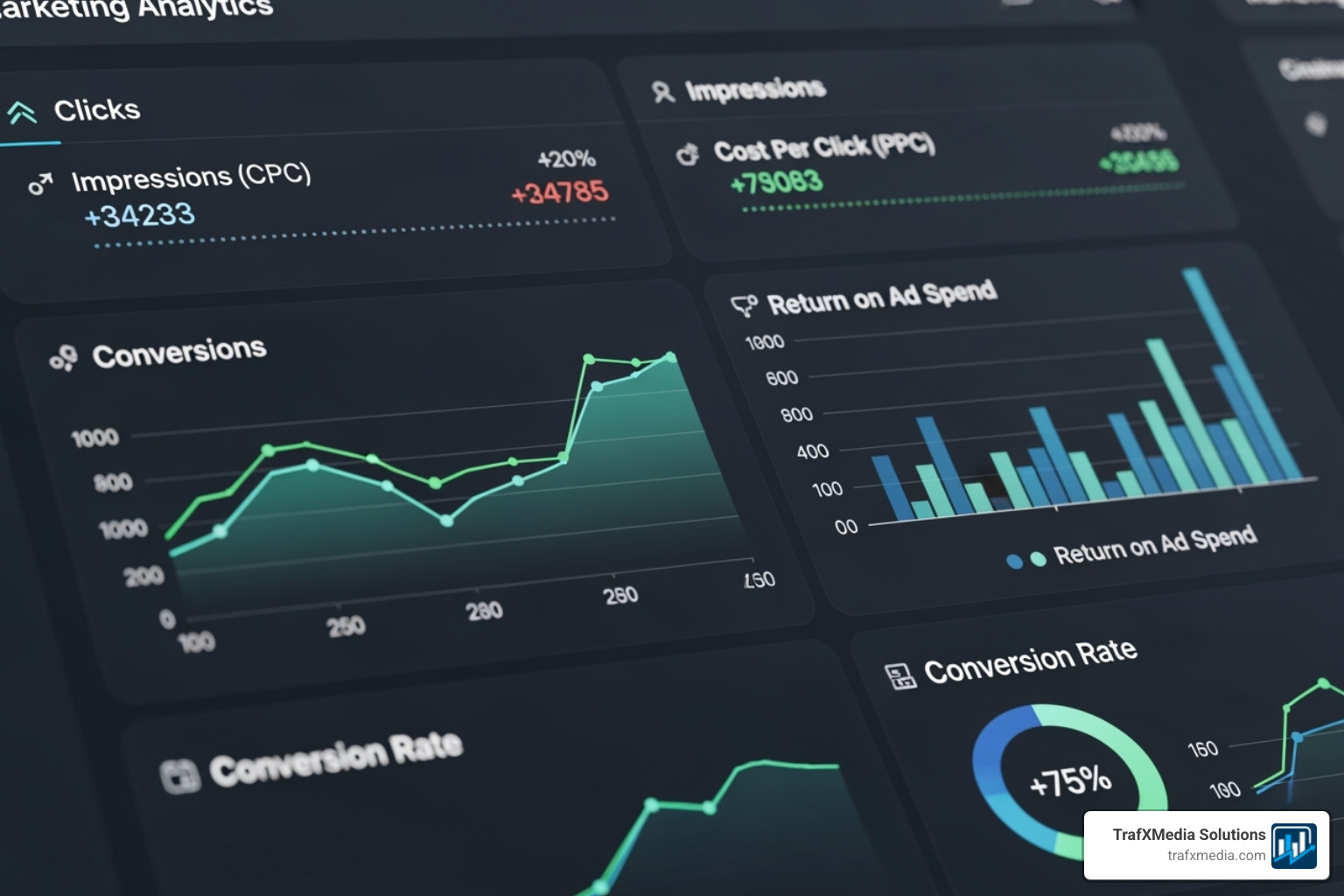
Launching your Google Ads campaigns is just the beginning of the journey. The true path to profitability and growth lies in diligent measurement, analysis, and continuous optimization. By understanding your data and turning insights into action, you can systematically improve your campaigns, making your advertising budget work smarter and harder for you.
Key Metrics That Truly Matter for Artists
It’s easy to get lost in the sea of data within the Google Ads dashboard. The key is to focus on the metrics that directly reflect your business goals, not just vanity metrics that look good on paper but don’t impact your bottom line.
- Impressions: The number of times your ad was shown. This is a top-level metric indicating your potential reach. Low impressions might mean your bids are too low or your targeting is too narrow.
- Clicks & Click-Through Rate (CTR): Clicks are the number of people who were interested enough to engage with your ad. CTR (Clicks ÷ Impressions) is a crucial indicator of your ad’s relevance. A high CTR means your ad copy and targeting are resonating with the audience. A low CTR suggests a disconnect that needs to be addressed.
- Cost-Per-Click (CPC): The average amount you pay for each click. This metric helps you understand the cost of acquiring traffic and manage your budget’s efficiency.
- Conversion & Conversion Rate: A conversion is the valuable action you want a user to take (a sale, a lead form submission, a phone call). The Conversion Rate (Conversions ÷ Clicks) is arguably the most important health metric for your campaign. It tells you what percentage of your ad clicks are turning into real business value.
- Cost Per Acquisition (CPA): Also known as Cost Per Conversion, this is your total ad spend divided by the number of conversions. It tells you exactly how much it costs you to acquire one lead or one sale. This metric is vital for determining profitability.
- Return on Ad Spend (ROAS): The ultimate measure of profitability. ROAS is the total revenue generated from your ads divided by your total ad spend. For example, if you spend $100 on ads and generate $500 in art sales, your ROAS is 5x, or 500%. This metric tells you if your advertising is a profitable investment.
To track conversions, CPA, and ROAS, you must set up conversion tracking. This involves placing a small piece of code on your website (often via Google Tag Manager) that reports back to Google Ads when a desired action is completed. Without it, you are flying blind. You can learn how to set this up on Google’s conversion tracking help page.
Smart Budgeting and Bidding Strategies
Your budget and bidding strategy determine how your money is spent. Google Ads offers a range of options to suit different goals and levels of expertise.
- Setting Your Daily Budget: You set a budget on a per-campaign basis. This is the average amount you’re willing to spend each day. Start with a modest, manageable amount that allows you to gather data without significant risk. You can always increase the budget for campaigns that prove to be profitable.
- Manual Bidding (e.g., Manual CPC): This gives you maximum control, allowing you to set a specific maximum bid for each keyword or ad group. It’s best for experienced advertisers who want to manage bids granularly but can be very time-consuming.
- Automated Bidding: This leverages Google’s AI to optimize your bids based on your campaign goal. This is the recommended approach for most artists. Common strategies include:
- Maximize Clicks: Aims to get as many clicks as possible within your budget. Good for driving initial traffic to a new website.
- Maximize Conversions: Aims to get the most conversions possible for your budget. Requires conversion tracking to be active.
- Target CPA (Cost Per Acquisition): You set a target cost per conversion, and Google’s AI will try to achieve it. Ideal for lead generation.
- Target ROAS (Return on Ad Spend): You set a target return for every dollar spent (e.g., 500%). Google will then bid to maximize your revenue while hitting this target. This is the gold standard for e-commerce artists.
Advanced Strategies to Lift Your Campaigns
Once you’ve mastered the fundamentals, you can implement these advanced tactics to gain a competitive edge:
- Strategic Retargeting (Remarketing): Don’t let interested visitors forget about you. Create specific audiences in Google Analytics or Google Ads, such as “All Website Visitors,” “Viewed a Specific Painting,” or “Abandoned a Shopping Cart.” Then, run custom Display or Video campaigns showing these warm audiences a compelling reason to return, like a special offer or a reminder of the piece they viewed.
- Building Hyper-Targeted Custom Audiences: Go beyond standard interest targeting. Create custom audiences based on users who have recently searched for specific long-tail keywords (e.g., “original abstract art for sale”) or who have visited the websites of specific art galleries, blogs, or even your direct competitors. This allows for incredibly precise and relevant ad targeting.
- Ad Scheduling (Dayparting): Analyze your campaign data to see which days of the week or hours of the day your conversions are highest. You can then schedule your ads to run only during these peak performance times, concentrating your budget when it’s most likely to convert and eliminating wasted spend during off-hours.
- Advanced Geo-targeting and Bid Adjustments: For local artists, you can target specific affluent neighborhoods or zip codes. You can also set bid adjustments to bid more aggressively for users in a specific city or less for users farther away. This allows you to tailor your budget allocation based on the geographic value of a potential customer.
- Integrating Google Ads with Your Email Marketing Funnel: Use your Google Ads campaigns not just to drive sales, but to build a long-term asset: your email list. Drive traffic to a landing page with a compelling offer in exchange for an email address (e.g., “Get 10% off your first print” or “Receive exclusive studio updates”). Once they are on your list, you can nurture the relationship over time through email marketing, building trust and turning subscribers into loyal collectors.
Frequently Asked Questions about Google Ads for Artists
Diving into paid advertising can bring up a lot of questions. It’s a powerful platform, but its complexity can be intimidating. Here are clear, straightforward answers to some of the most common questions artists have about using Google Ads.
What are the most common (and costly) mistakes artists make with Google Ads?
- Vague Keyword Targeting: The single biggest mistake is using overly broad, single-word keywords like “art” or “music.” This is the digital equivalent of shouting into a hurricane. You’ll exhaust your budget on irrelevant clicks from people searching for art history, clip art, or music lessons. The key is to use specific, long-tail keywords (e.g., “handmade ceramic coffee mugs for sale”) that signal strong buyer intent.
- Ignoring Negative Keywords: Failing to actively build a negative keyword list is like leaving a hole in your pocket. Every irrelevant search that triggers your ad is wasted money. Regularly review your “Search Terms” report and add terms like
free,jobs,tutorial,DIY, andexamplesto your negative keyword list to keep your targeting sharp. - Neglecting Conversion Tracking: Running ads without conversion tracking is like trying to steer a ship in the dark without a compass. You can see that you’re moving (getting clicks), but you have no idea if you’re heading toward your destination (profitability). Setting up conversion tracking is non-negotiable; it’s the only way to measure your ROI and make data-driven decisions.
- A Poor Landing Page Experience: You can have the best ad in the world, but if it leads to a slow, confusing, or untrustworthy landing page, you will not get conversions. Your landing page must be a seamless extension of your ad, with a clear message, fast load times (especially on mobile), and a simple path to purchase or inquire.
- “Set It and Forget It” Mentality: Google Ads is not a slow cooker. It requires active management. Successful campaigns are the result of continuous monitoring, testing, and optimization. You should be checking in on your account at least weekly to review performance, pause underperforming ads or keywords, and identify new opportunities.
How can I effectively promote a one-time event like a music gig or art exhibition?
For time-sensitive events, you need a focused, multi-channel approach:
- Use Geo-Targeting Aggressively: Your primary goal is to reach people within a reasonable travel distance. Use tight radius targeting around the venue or target specific cities and zip codes. You can also layer on income targeting if you’re promoting a high-ticket event.
- Create Event-Specific Search Campaigns: Target keywords like “art gallery opening near me,” “live music this weekend in [Your City],” or the name of your exhibition/band. Use ad copy that creates urgency with dates and phrases like “Showing This Week Only” or “Tickets Selling Fast.”
- Run Visual Buzz Campaigns: Use Display and YouTube Video campaigns in the weeks leading up to the event to build awareness and excitement. Showcase engaging visuals of the artwork, a trailer for the exhibition, or clips of the band performing. Retarget these viewers in the final days before the event with a direct call-to-action to buy tickets or RSVP.
- Use Ad Scheduling: Run your ads more heavily in the evenings and on weekends when people are actively making plans.
How much should an artist budget for Google Ads?
There is no magic number, and you don’t need a massive budget to start. The better question is, “How much is a new customer or sale worth to me?” Start with a small, controllable daily budget you are comfortable losing while you test and learn—perhaps $10-$20 per day. The goal is not to spend a lot, but to achieve a positive Return on Investment (ROI). Once you have a campaign that is demonstrably profitable (e.g., for every $1 you spend, you make $4 back), you can confidently reinvest a portion of those profits to scale your budget. This creates a sustainable, self-funding growth engine for your art business.
Is Google Ads better than social media ads (like Facebook/Instagram) for artists?
They are not better or worse—they are different tools for different jobs, and they work best together.
- Google Ads (Search) is for “demand capture.” You are reaching people who are already aware they have a need and are actively seeking a solution (e.g., “buy art for my home”). It’s highly transactional and intent-driven.
- Social Media Ads are for “demand generation.” You are reaching people based on their interests and demographics, introducing them to your work, and building a community. It’s about findy, branding, and top-of-funnel awareness.
A powerful strategy is to use Instagram ads to build an audience and drive initial website traffic, then use Google Ads retargeting to bring back those interested visitors to close the sale.
My art is very niche. Will Google Ads still work for me?
Absolutely. In fact, a niche can be a major advantage in Google Ads. While you may not have massive search volume, the people who are searching for your specific niche are incredibly qualified and motivated. This is where long-tail keywords (“medieval-style illuminated manuscript commissions”), custom audience targeting (targeting visitors of specific historical reenactment blogs), and YouTube placement targeting (showing your video ad on a niche channel) become your superpowers. You can bypass the broad, expensive competition and connect directly with the small but passionate community that will love your work.
Take Your Art to the Next Level
Throughout this guide, we’ve journeyed from the foundational principles of goal setting to the advanced strategies of digital advertising. We’ve demystified how Google ads for artists can dismantle the old gatekeeper model and empower you to build a direct line to your audience, changing your creative passion into a viable, thriving business.
The single most profound benefit of this platform is its ability to connect you with the right person at the perfect moment. When an interior designer in San Francisco searches for a “local abstract painter for a corporate project,” your ad can be their answer. When a fan of your music genre looks for “new indie folk artists to follow,” your video can be their next findy. This isn’t just marketing; it’s precision-engineered opportunity. This approach delivers a transparent, measurable return on your investment and grants you complete control over your marketing destiny.
However, success is not a passive outcome. It demands a commitment to continuous learning and optimization. By diligently analyzing your data, testing your creative, and refining your strategy, you move beyond simply running ads and begin to have a meaningful, data-informed conversation with your audience. You learn what resonates, what inspires action, and how to connect more deeply with the people who value your work.
As a San Francisco-based artist, your unique perspective and creative voice deserve to be seen and heard far beyond your local community. A well-executed digital strategy is the bridge that connects your studio to the world, turning clicks into collectors, views into fans, and building a sustainable, independent path for your artistic career.
If you’re a local artist ready to stop waiting to be finded and start taking control, you don’t have to do it alone. TrafXMedia Solutions is a friendly, hands-on partner specializing in crafting bespoke advertising strategies that drive real, measurable results for creatives just like you. Let’s work together to ensure your art gets the brilliant spotlight it deserves. Ready to truly lift your artistic career? Get a custom Google Ads plan designed for your art business.

